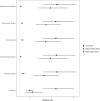How do early-life factors explain social inequalities in adolescent mental health? Findings from the UK Millennium Cohort Study
- PMID: 31492761
- PMCID: PMC6877708
- DOI: 10.1136/jech-2019-212367
How do early-life factors explain social inequalities in adolescent mental health? Findings from the UK Millennium Cohort Study
Abstract
Background: Reducing inequalities in adolescent mental health is a public health priority, yet the pathways that link social conditions to mental health outcomes in the early years are unclear. We aimed to evaluate the extent to which early years risk factors explain social inequalities in adolescent mental health in the UK.
Methods: We analysed data from 6509 children captured in the UK Millennium Cohort Study. Mental health was assessed through the socioemotional behavioural problems at age 14 (Strengths and Difficulties Questionnaire). The main exposure was maternal education at birth, used as a measure of childhood socioeconomic conditions (SECs), and used to calculate the relative index of inequality. Using causal mediation analysis, we assessed how perinatal, individual child, family, peer relation and neighbourhood-level factors measured up to age 3-mediated the total effect (TE) of SECs on adolescent socioemotional behavioural problems, estimating the proportion mediated and natural indirect effect (NIE) via each block of mediators, and all mediators together.
Results: Children of mothers with no qualification were almost four times as likely to have socioemotional behavioural problems compared with degree plus level (relative risk (RR) 3.82, 95% CI 2.48 to 5.88). Overall, 63.9% (95% CI 50.2% to 77.6%) (NIE RR 1.97, 95% CI 1.63 to 2.37) of the TE (RR 4.40, 95% CI 3.18 to 6.07) of social inequalities on risk of adolescent socioemotional behavioural problems was mediated by early-life factors.
Conclusions: About two-thirds of the social inequality in adolescent mental health was explained by early risk factors measured by age 3, highlighting the importance of public health interventions in this period.
Keywords: EPIDEMIOLOGY; Lifecourse / Childhood Circumstances; MENTAL HEALTH; SOCIAL INEQUALITIES.
© Author(s) (or their employer(s)) 2019. Re-use permitted under CC BY. Published by BMJ.
Conflict of interest statement
Competing interests: None declared.
Figures



Similar articles
-
How do early-life adverse childhood experiences mediate the relationship between childhood socioeconomic conditions and adolescent health outcomes in the UK?J Epidemiol Community Health. 2020 Nov;74(11):969-975. doi: 10.1136/jech-2020-213817. Epub 2020 Aug 27. J Epidemiol Community Health. 2020. PMID: 32855260 Free PMC article.
-
Understanding pathways to inequalities in child mental health: a counterfactual mediation analysis in two national birth cohorts in the UK and Denmark.BMJ Open. 2020 Oct 12;10(10):e040056. doi: 10.1136/bmjopen-2020-040056. BMJ Open. 2020. PMID: 33046476 Free PMC article.
-
Disadvantage in early-life and persistent asthma in adolescents: a UK cohort study.Thorax. 2022 Sep;77(9):854-864. doi: 10.1136/thoraxjnl-2021-217312. Epub 2021 Oct 14. Thorax. 2022. PMID: 34650003 Free PMC article.
-
The effect of a transition into poverty on child and maternal mental health: a longitudinal analysis of the UK Millennium Cohort Study.Lancet Public Health. 2017 Mar;2(3):e141-e148. doi: 10.1016/S2468-2667(17)30011-7. Epub 2017 Feb 16. Lancet Public Health. 2017. PMID: 29253387
-
Mediators of socioeconomic inequalities in preterm birth: a systematic review.BMC Public Health. 2022 Jun 7;22(1):1134. doi: 10.1186/s12889-022-13438-9. BMC Public Health. 2022. PMID: 35668387 Free PMC article.
Cited by
-
Trends in inequalities in Children Looked After in England between 2004 and 2019: a local area ecological analysis.BMJ Open. 2020 Nov 23;10(11):e041774. doi: 10.1136/bmjopen-2020-041774. BMJ Open. 2020. PMID: 33234654 Free PMC article.
-
How do early-life adverse childhood experiences mediate the relationship between childhood socioeconomic conditions and adolescent health outcomes in the UK?J Epidemiol Community Health. 2020 Nov;74(11):969-975. doi: 10.1136/jech-2020-213817. Epub 2020 Aug 27. J Epidemiol Community Health. 2020. PMID: 32855260 Free PMC article.
-
Phenotypically independent profiles relevant to mental health are genetically correlated.Transl Psychiatry. 2021 Apr 1;11(1):202. doi: 10.1038/s41398-021-01313-x. Transl Psychiatry. 2021. PMID: 33795632 Free PMC article.
-
The Impact of Place-Based Approaches Addressing Mental Health and Substance Use Among Adolescents: A Systematic Review of the Literature.Public Health Rev. 2025 Feb 14;45:1607955. doi: 10.3389/phrs.2024.1607955. eCollection 2024. Public Health Rev. 2025. PMID: 40027468 Free PMC article. Review.
-
Does household income predict health and educational outcomes in childhood better than neighbourhood deprivation?J Public Health (Oxf). 2025 Feb 28;47(1):62-73. doi: 10.1093/pubmed/fdae283. J Public Health (Oxf). 2025. PMID: 39657973 Free PMC article.
References
-
- Gunnell D, Kidger J, Elvidge H. Adolescent mental health in crisis. we need to understand the causes to inform prevention. BMJ 2018;361. - PubMed
-
- Office for National Statistics Insights into children’s mental health and well-being, 2015. Available: http://webarchive.nationalarchives.gov.uk/20160105160709/http://www.ons....
Publication types
MeSH terms
Grants and funding
LinkOut - more resources
Full Text Sources
Medical
